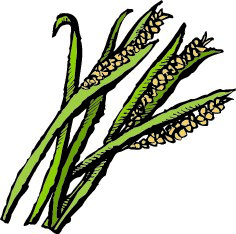
Buyer’s guide to rice
How is rice grown and harvested?
Rice is planted in the spring and, in most cases, the paddy fields are filled with a shallow layer of water. The water helps keep the baby rice plants warm during cool spring nights, and it helps to drown out any plucky weeds. The rice paddies must be perfectly flat, or the water will pool in some places and leave others bone dry – that’s why when rice is grown in mountainous regions the land has been carved into terraces.
Rice is ready for harvesting in the fall. After the harvest, the rice needs to be dried, either in big ovens or by the sun. If the rice wasn’t dried, it would mold and spoil quickly. After drying, the hulls are removed. If you’re after white rice, the bran and germ get polished off, too. Finally, the rice rests for a couple of months so that the starches set. If you tried to cook the rice right away, it would be mushy. Holding onto the grains until the new year makes for better texture when the rice is cooked.
What’s the difference between “brown” rice and white rice?
What we call “brown” rice is the whole grain with the hull removed. White rice further has the bran and most of the germ removed. Removing the bran and germ to make white rice takes away nutrients, fiber, oils, and often a lot of flavor and texture. It’s the same idea as the difference between stone ground heirloom grits or oatmeal and the industrially processed stuffed made using modern roller mills: keeping the grain more intact keeps the flavor more intact. But also like with cornmeal, keeping the grain intact with its oils means that it can go rancid more quickly. Whereas white rice can keep for a decade or more, brown rice should be used within a year or so.
“Brown” rice doesn’t have to be brown. You can find rice that’s minimally processed like brown rice that happens to be red, black, purple, or even white in color. The different colors contribute to the nutrients and flavor of the rice.

Wild rice recipes
You’ve got your hands on one of America’s almost-lost foods, really wild (not paddy grown) wild rice. You’re in for a treat. Here are a couple ways to enjoy it.
A recipe for basic wild rice
Ingredients
3-4 cups broth or water
1 cup really wild rice
Sea salt to taste
Method
Bring broth and salt to a boil. Add the wild rice, bring back to a boil. Reduce the heat, cover and simmer until rice is tender but firm and the grains have burst open, roughly 20 to 60 minutes.
A recipe for a little more than basic wild rice
Ingredients
3-4 cups broth or water
1 cup really wild rice
A small onion, chopped fine
A couple teaspoons of extra virgin olive oil
A cup or so of mushrooms like chanterelles, chopped in pieces
A small handful of chopped chives
Sea salt to taste
Method
Bring broth and salt to a boil. Meanwhile, sweat onion in olive oil—if the edges get brown the pan is too hot. When the onion is soft and translucent add the mushrooms. Cook for a minute, then add the rice. Stir until the rice is coated with oil. Turn the heat up a bit and let everything cook for a minute or two. Add the broth, stir once or twice, and after the broth boils lower the heat to a soft simmer and cook for 20-40 minutes. The rice will be tender but firm, the grains burst open. Serve topped with chives.
One other ways to enjoy your really wild rice
You can use it in soups, in stews, as a side dish, in wild rice salads—really, in almost any type of dish in which you’d use regular white rice.
One alternative method of making wild rice that was told to me: “The Native Americans soak the rice in cold water overnight or longer. They drain the water. They put a strip of bacon into a frying pan and then they throw the soaked rice into frying pan warm with the bacon. They don’t boil it. Soaking in the cold water accomplishes the cooking.”